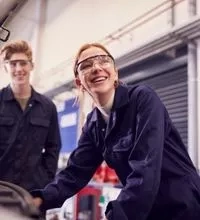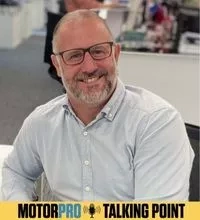The big interview: Dr Andy Palmer

Dr Andy Palmer has masterminded some of the industry’s most iconic vehicles and led a global sector, but after starting out as an apprentice he’s now determined to turbocharge that route into automotive. MotorPro sits down with the founder and chair of the Palmer Foundation to find out more.
What first drew you to a career in the automotive sector?
My dad was a manufacturing engineer so the inspiration came from watching him and seeing what he was doing. When I was 14, he bought me an old A-series engine that I spent the summer holidays taking to pieces and putting back together. I was good at things like technical drawing and metalwork, and not bad at maths and physics, so I knew I wanted to go into the automotive industry and become an engineer.
However, I didn’t get any support from the school as they didn’t see engineering as a particularly attractive place to go. Because I lived in Stratford-upon-Avon, my careers officer actually suggested I go into scenery design for theatres.
How did your automotive career get going?
There was a company called Automotive Products (AP), which made clutches and brakes, and I ended up in their advanced engineering division developing the forerunner to double-clutch automatic. Double-clutch transmission didn’t really work back then because we were on the cusp of moving from analogue to digital. Without digital electronics, you would get drift.
I did seven years in that company, including four years as an apprentice. As you came out of your apprenticeship, you were obliged to join the union – it was a closed shop. It was 1984, right in the middle of the wildcat strikes at Austin Rover. As a 20-year-old, I looked at it all and thought: ‘This is mad!’.
Management wants people to work and workers want to work – they want money. When you have that level of alignment it’s ridiculous that people were going on strike every few weeks.
Arrogantly, I thought that I could do it better, and as it was principally a management issue, the solution was better management. I thought I had better capability. As I came out of my apprenticeship, I went to night school at what is now Coventry University and did an industrial management degree. I came out as Management Student of the Year in the UK and used that to leave AP and get into Rover.
Why did you then decide to leave Rover and join Nissan?
Rover was working with Honda so I was able to look at the powertrains coming from both and they were chalk and cheese in terms of reliability. I needed to understand what the Japanese were doing so well at the time. My three-year plan was to get their know-how and bring it back to the UK, but ultimately the British car industry fell away during that period and I ended up spending 23 years at Nissan.
I really enjoyed the philosophical view and the contrast of the Japanese approach. I’d been incredibly arrogant during the interview process because I said I wanted to be the CEO of Nissan. I think the Japanese found it quite amusing.
At Nissan, you pushed through arguably the first commercially successful electric vehicle – the Nissan Leaf – at a time when EVs weren’t being pushed. Why start such a mammoth project?
It was the first mass-production electric vehicle and the first to use a lithium-ion battery. Toyota were kicking Nissan’s ass with the Toyota Prius so we were losing C-segment share around the world, but particularly in Japan. My sales team were banging on my door shouting ‘We need a hybrid.’ My view was the opposite. Honda decided to follow the Prius with the Insight and got crushed, so my view was that we needed to leapfrog Toyota.
I knew that there was a lot of Nissan technology buried inside their advanced engineering division, and in the discussion about leapfrogging, there seemed to be a natural conclusion that we could do an electric vehicle. The idea of an electric programme was born and we did it properly, on an electric-dedicated platform.
We had a lot of air cover from Carlos Ghosn [former chairman and CEO of Nissan] because the programme was never going to make any money. In the beginning, it didn’t even cover its material costs, but it was seen as a way of living the ‘Innovation that Excites’ slogan at the time, as well as coming back and improving the brand.
Before I left, I had a programme of five cars. I managed to execute Leaf and the e-NV200, but there was a lot of resistance within the company to saying that future technology is hydrogen or hybrid.
Why did you leave Nissan to become CEO of the struggling Aston Martin?
I’d done some due diligence on Aston Martin about a year before because it seemed that Aston fitted very well in the product stack of Datsun, Nissan and Infiniti, but I couldn’t get the company over the line to acquiring it.
When Aston called, it was an iconic car company and I thought I had the toolset that would help it succeed. My first meeting with the CFO at the time was like, ‘We’re three months away from going bankrupt.’ I thought, hold on a second. I’ve just jump shipped from a very secure job and the company’s going bankrupt.
James Bond saved the company. We’d done a car for Spectre, which was the DB10. We were able to capitalise on it because it was the prototype for the Vantage. Through that capitalisation, we were able to meet the EBITDA target. That got me to January, when I could take the plan for growth and recovery to the board and the requirement to raise £200m.
They gave me room and helped me raise the £200m that I needed to find a fast revenue generator to get me to DB11. The fast revenue generator was the advent of the limited series cars: the Vulcan, Zagato series, GT12 and GT8. We took fairly big deposits upfront for those and that improved our liquidity.
DB11 funded Vantage, Vantage funded DBS, DBS funded DBX, which was a new plan, the SUV. I knew that ultimately, if Aston was going to be long-term sustainable, I needed to have a range of vehicles with a mid-engine like Ferrari.
But you couldn’t just make a mid-engine; there wouldn’t have been any legitimacy in it. That’s why I took the company into Formula One, with the Valkyrie bridging the gap between Formula One and a top-of-the-range road car.
We didn’t go bankrupt during my period. In fact, it was the first time the company was profitable. What a fabulous legacy to leave the company, particularly with the DBX and the Valkyrie, probably two of the best products in that room. For me, the Valkyrie is the pinnacle of internal combustion engines.
Since leaving Aston Martin you have split your time between a number of companies and projects. One boosts apprenticeships through your Palmer Foundation charity. How’s that project going?
Apprenticeship is sometimes an abused term, but a proper invented indentured apprenticeship with a qualification should be treated with prestige. Having a skills shortage means that people will pay attention and apprenticeships are a good way of doing that.
One of the areas you could look for apprentices is people that are brought up in a difficult environment. Some of those people will have a natural propensity towards STEM. The charity aims try to capture those people at about 14 years old.
I use my friends in the industry. If someone is recruiting, for example, 50 apprentices, I’ll ask if they can recruit 52 and I’ll pay for the extra two. The charity pays the salary, NIV, employment costs, training costs, and everything else for those two people, which will then take them to 18. Hopefully by the time they get to
18, they will be useful to the employer, who will either keep them on as an apprentice or put them on a degree course at Coventry University.
The apprentices are always part of the family, always part of the network, and each quarter we have meetings that engage them with motivational speakers giving lectures on different subjects.
We also have a really successful relationship going with Halfords. It gives me access to Level 2 and 3 apprenticeships to enable them to become a mechanic or an MOT tester. Hopefully I’ll have about 10 apprentices starting that in September, accelerating our work.
How would you explain to a new generation of talent or their parents or carers that automotive is a good career choice?
Automotive is the king of industries. It has everything, but most importantly, it has a product that you can see every day. You can be an engineer, a marketeer, a salesperson. You can work in finance, in legal, in HR. You can find all the functions within an infrastructure that looks after you.
It doesn’t matter whether you’re a janitor, a lawyer or an engineer, every one of you in that company takes a little part of you and embeds it into the product. You’ve got something that’s tangible and pleasing people, and that’s the key to why I love the car industry: you create products of the heart using your head.
This is an edited version of the feature from IMI's new MotorPro magazine, received free as part of IMI membership.




